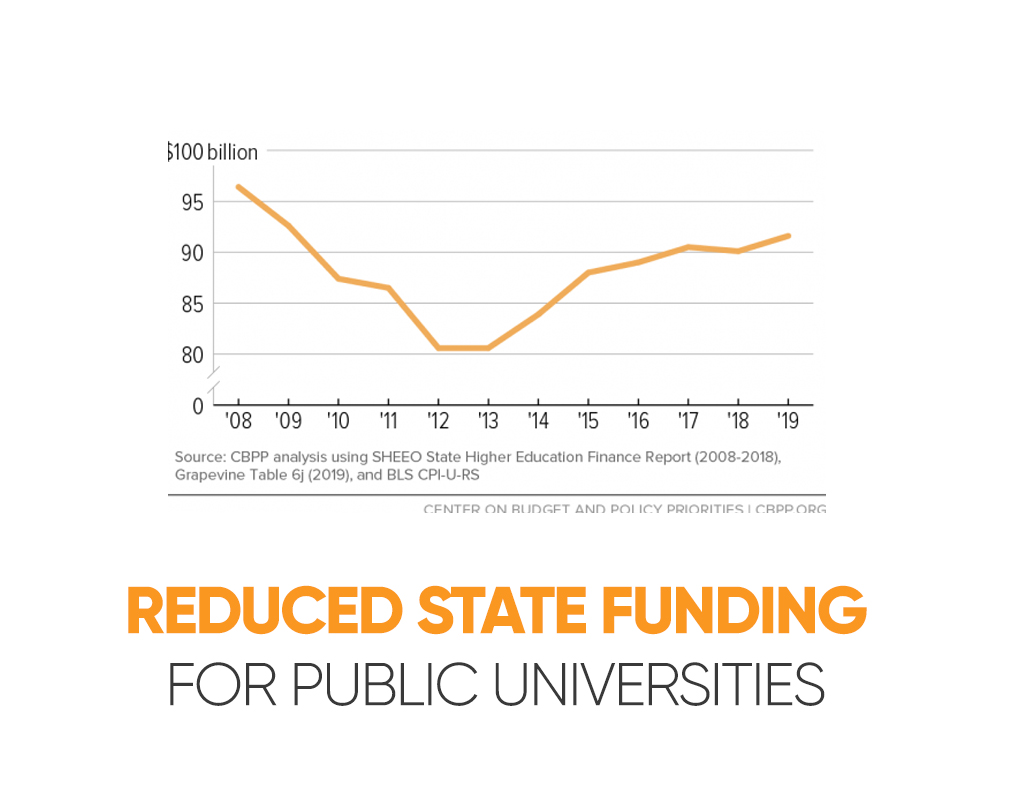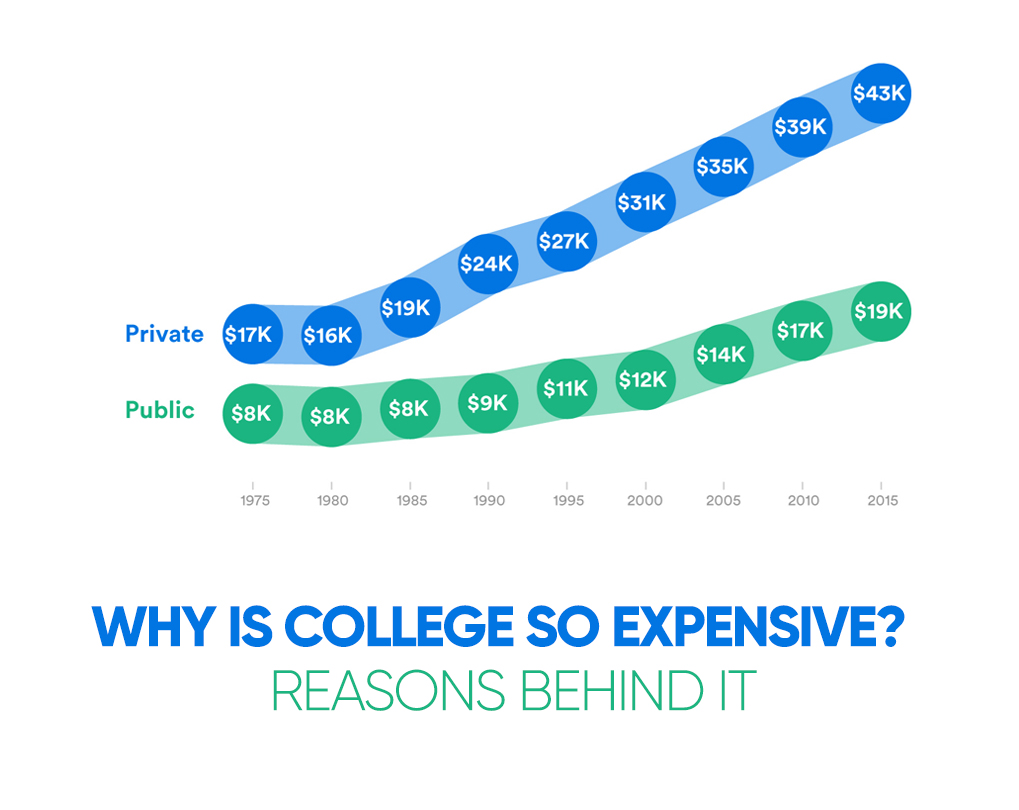Why is College so Expensive? Over the earlier 2 decades, distributed college tuition has grown in price more than any other good or service besides clinic care. The tuition increase has flown at a speedier rate than the cost of medical co-operations, child care, and housing. While large financial aid means that students normally pay far less than the “sticker price” of tuition, the net price of public 4-year colleges has still more than doubled since the shift of the century. Furthermore, underlying costs at American colleges are the highest of any big country in the advanced world.
Current college students suffer not only higher loan amounts than in the past, but also higher obstacles to paying these loans off in the form of dormant payments and growing costs of living over the country.
Notwithstanding the costs, several students (and parents) feel coerced to take on student loan debt. One reason can be that a college education is heavily correlated with an upward social movement. However, a study from Opportunity Insights discovers that low-income students’ entrance to high-mobility institutes has been decreasing since 2000.
More than eternally, parents and students have to balance the load of college charges upon the benefit of a college degree. But why is college so expensive? Here are some reasons why the common cost of education has skyrocketed.
Rising Expenses, Rising Tuition
The 2019 report reveals just how much normal college cost has jumped in recent years. From 1989-1990 to 2019-2020 scholastic years, average tutoring and pays more than doubled at private 4-year institutions and tripled at unrestricted 4-year Universities.
Section of the reason why institutes charge more now is because of rising expenses for teaching and housing students at both public and private academies, according to a study from the Lumina Foundation, a training nonprofit. These responsibilities include administration and instruction, student health care, athletic programs, food service, maintenance, housing, as well as a more recent expense – marketing.

Reduced State Funding for Public Universities
The different reason college is so high in pay is that state and federal funding for public academies remains to decline. Lumina Foundation study shows that government scholarships for higher learning, amount to wicked more than half of the total education funds taken by universities and public colleges. This is significantly smaller than during the late 1980s when public assistance amounted to 77 percent of these equal funds nationwide.
The funding price differs broadly from state to state, from a study of the University of California, Berkeley. For instance, Wyoming includes 86 percent of costs, enabling the state’s public universities to lower tuition. On the other hand, New Hampshire includes just 16 percent of costs with taxpayer supplies.
The College Board’s 2019 trends article gives more instances of these wide funding differences. From 2017-2018, local and state funding for public greater education ranged from $3,190 in Vermont to $17,700 in Alaska. The article also writes that 2017-2018 state and local funding for every student was 9 percent cheaper than a decade earlier and 10 percent lower than in 1987-1988.
Students Demand More Services
Also, learner expectations about what kinds of assistance academies should afford to continue to develop and improve. For instance, numerous students want more excellent career services to help them get internships and jobs after graduation.
Learners also require schools to offer state-of-the-art amenities, far-ranging student support, as well as the most advanced technology from VR headsets to 3D printers. As schools spend more to match student expectations, prices for students go up.
Costly Administrative Overhead
You can imagine that high tuition checks give professor wages, but it’s truly the burden for administrator positions that puts the greatest strain on academy pocketbooks.
A 2019 book on the tuition dilemma remarked on large administrative costs at American academies. For instance, at public universities in California, Alaska, and Texas, administrators and administrative costs have outpaced increase rates for educational personnel and staff.
Private Colleges and For-Profit Universities
Several private universities and for-profit colleges charge considerably higher tuition than their public counterparts, without granting the equal level of financial aid that might give them realistic opportunities for low earnings students. Since numerous smaller institutes are in lower sports groups, they also don’t mind to award athletic scholarships, further limiting available aid.
Numerous parents and students who have given higher tuition for tiny private institutes query if it was all worth it. While these institutes serve to have special perks in common, similar lower student-to-faculty ratios, expensive colleges on the website Niche lament older dorm buildings, some reviews of small, marginal academic quality, fewer campus activities, and a lack of diversity.
Tuition Prices Aren’t Regulated
Unlike different countries, the US does not cap tuition costs. Studies state that one-third of grown countries give free higher education while extra third caps tuition at very cheap prices- often fewer than $2,400 a year.
Meantime, tuition charges in the US last to rise without guidance. To get students fitted of paying, several universities attempt to attract more out-of-state and international candidates. These candidates often spend to double the cost that local students do and the international students can pay triple the price.
FAQs
[wps_faq style=”classic” question=”Q: Why should college be cheaper?”]A: The reason people don’t attend college or choose to stop after four years is that it’s too expensive. A cheaper college education means a more educated nation and an overall more efficient and productive society. Education is the foundation of society.[/wps_faq][wps_faq style=”classic” question=”Q: What is the average cost of college in 2020?”]A; In studying only at schools listed in the National Universities category, for instance, the average price of tuition and fees for the 2020 – 2021 school year was $41,411 at private institutes, $26,809 for out-of-state students at state schools, and $11,171 for state residents at public colleges.[/wps_faq][wps_faq style=”classic” question=”Q: Why is free college a bad idea?”]A: Few reasons Student loan defaults will increase. Completion rates will decrease. Property taxes will increase.[/wps_faq][wps_faq style=”classic” question=”Q: Why is free education important?”]A: Free study is necessary because it ensures each student in a country some level of learning. This implies that each student has the same chance to obtain this level of education on an equal scale. And education is the key to a stable life.[/wps_faq]
Conclusion
The price of the institute has been steadily increasing over the past decade (at least), and the continuing COVID-19 pandemic could make more education even more unaffordable, analysis shows. And 56 percent of students feel they can no longer easily pay their charge, according to a June 2020 study. The poll also discovered that 7 percent of respondents have had to unenrolled to get a full-time profession or alternative education choices.


